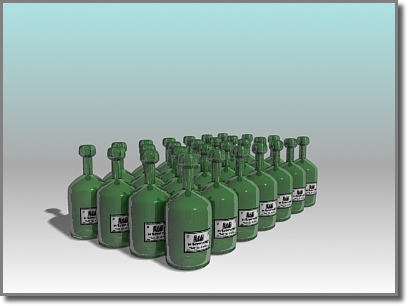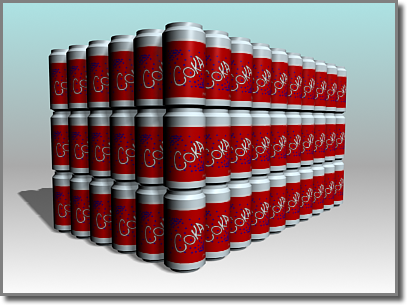The Array dialog provides two main control areas where you set the important parameters: Array Transformation and Array Dimensions.
You can set parameters in any order, but in practice it’s useful to start with Array Transformation. This creates the basic building block for the larger array, as defined by Array Dimensions.
These topics discuss specific strategies for using these controls:
Creating Circular and Spiral Arrays

This area lists the active coordinate system and transform center. It’s where you set the transforms that define the first row of the array. You decide here on the distance, rotation, or scale of individual elements, and along what axes. You then repeat this row in other dimensions to produce the finished array.
Move, Rotate, and Scale Transforms
You set Move, Rotate, and Scale parameters along any of the three axes of the current coordinate system.
For each transform, you have the choice of whether to apply the transforms successively to each newly created element in the
array or to the overall array. For example, if you set Incremental  X
X  Move to 120.0 and Array Dimensions
Move to 120.0 and Array Dimensions  1D
1D  Count to 3, the result is an array of three objects, each of whose transform centers is 120.0 units apart. However, if you
set Totals
Count to 3, the result is an array of three objects, each of whose transform centers is 120.0 units apart. However, if you
set Totals  X
X  Move to 120.0 instead, the three elements are spaced 40.0 units apart for a total array length of 120.0 units.
Move to 120.0 instead, the three elements are spaced 40.0 units apart for a total array length of 120.0 units.
Incremental and Totals settings are toggles for each transform. When you set a value on one side, the other side is unavailable. However, the unavailable value updates to show the equivalent setting.
Incremental: Parameters set on this side apply to individual objects in the array. Here are examples:
Totals: Parameters set on this side apply to the overall distance, number or degrees, or percentage scale in the array. Here are examples:
Creates new array members as references of the originals.
For further information, see Overview of Copies, Instances, and References.
The Array Dimensions controls determine the number of dimensions used in the array and the spacing between the dimensions.
Count: The number of objects, rows, or layers in each dimension.
1D: One-dimensional arrays form a single line of objects in 3D space, like a line of columns. 1D Count is the number of objects in a row. Spacing for these objects is defined in the Array Transformation area.

A one-dimensional array, with 1D Count=6
2D: Two-dimensional arrays form a layer of objects along two dimensions, like the rows of squares on a chess board. 2D Count is the number of rows in the array.

A two-dimensional array, with 1D Count=7 and 2D Count=4
3D: Three-dimensional arrays form multiple layers of objects in 3D space, like neatly stacked boxes. 3D Count is the number of layers in the array.

A three-dimensional array, with 1D Count=10, 2D Count=6, 3D Count=3
These parameters become available when you choose a 2D or 3D array. These are distances along any of the three axes of the current coordinate system.